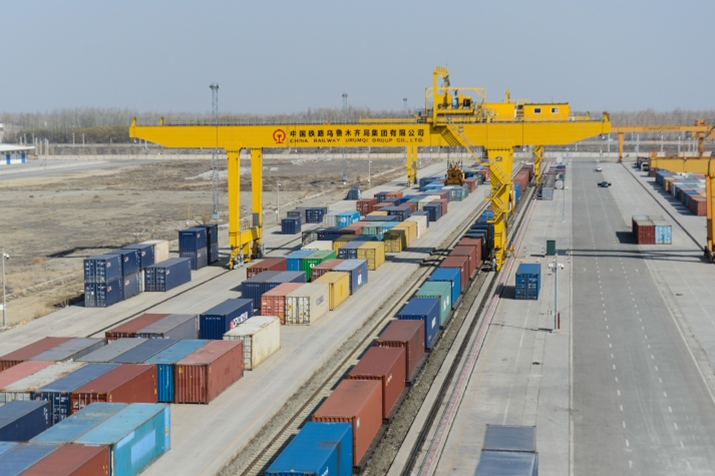| Latest Cover |
| Xinjiang raises the stakes in overland cargo transportation | |
|
|
 Giant cranes transship containers at a railway station on the Chinese border with Kazakhstan on March 23, 2019 (XINHUA)
Xinjiang, an autonomous region in northwest China, is home to vast deserts and mountains and many ethnic minority groups. The ancient Silk Road trade route linking China and the Middle East once passed through Xinjiang, and its legacy can still be seen everywhere. The dry port of Horgos today breathes new life into this earliest of routes. Horgos, once a sleepy backwater straddling the border of Xinjiang's Ili Kazak Autonomous Prefecture and Kazakhstan, has been transformed as a key part of China's Belt and Road Initiative. Its strategic position has turned the city into the one of the largest dry ports in the world and a starting point for the China-Europe railway. And demand is on the rise. Thanks to the dry port, trains and trucks can carry goods from east China to West Europe in around two weeks, compared to a several-week journey by container ship or vastly expensive air freight. Harboring new development As economies around the world reeled from COVID-19-related countermeasures, demand for made-in-China products soared. China posted a huge $535 billion trade surplus in 2020 according to the General Administration of Customs of China; a 3.6 percent increase in exports over 2019 to a total of $2.6 trillion; and a 1.1 percent reduction in imports. At the same time, China overtook the U.S. to become the EU's top trading partner in goods, according to Eurostat data. Due to various reasons, shipping rates reached a 12-year high at the end of last year. The Suez Canal blockage also sounded alarms for international traders, showing how important it is to have alternatives. This sudden spike in sea freight rates and increased shipping delays—all combined to make the rail freight option very attractive in 2020. At Horgos itself, three giant rail-mounted gantries rise from the desert and meticulously move up and down the lengths of freight trains arriving from China and load them onto trains waiting on Kazakhstan's tracks all backed by a snow-capped mountain range. These giant cranes are needed to transship containers onto Kazakhstan's trains and vice versa as Kazakhstan's rail uses slightly wider former Soviet rail lines. In addition to the railway terminal, a new highway crossing from China to Kazakhstan opened in November 2018. According to Yu Chengzhong, Chairman of the Board of Jinyi International Trade Group, 45 percent of the port's cargo already originates from outside Xinjiang. He explains how provinces closer to the sea are switching to the overland route; from oranges in Hunan Province, to consumer products in Henan Province. The development of the dry port has been impressive: Productivity at the port has rocketed in recent years and it now handles over 180,000 TEUs a year, Yu told Beijing Review. That figure is expected to rise to 500,000 TEUs by 2023. "Before the port was built it would take three days to reach Astana in Kazakhstan, all on dirt roads," Yu explained, "But now it's all express highway or rail freight so the time is just hours." Although some 80 percent of the goods shipped through Horgos go to the Central and Eastern European countries, 35-40 percent to Uzbekistan alone. On January 3, 2017, the first Yiwu to London train departed, carrying 44 containers via Moscow and Minsk and arriving at London's Barking Eurohub freight terminal. On April 10 of that same year, the first London to Yiwu train departed, carrying 88 containers covering the 12,000-km journey in just 18 days—compared with the 40 days for sea freight. Added to this, the port at Horgos provides a train route via Almaty and across Central Asia to Tehran, with the first cargo trains arriving in Iran in 2018 after completing the 10,400-km journey in just 14 days and giving China increased access to this energy-rich region.  The port city of Horgos on May 29. It is a gateway to Central Asia (RYAN PERKINS)
Port and road initiatives Nevertheless, the port's development has also been a driver for local industries in Xinjiang. And horticultural projects have sprung up in the Ili region. Where once there was open grassland, vast fields of flowers bloom and fields of lavender stretch to the horizon. Yet Horgos is not Xinjiang's only trade route under development. Xinjiang's oasis city of Kashgar has a history stretching back more than 2000 years and was a key trading post along the historical Silk Road. Nowadays, it is the starting post of the China-Pakistan Economic Corridor (CPEC), one of the biggest projects under the Belt and Road Initiative (BRI). Over the course of decades, overcoming many a challenge given the formidable terrain, roads have been constructed, running from Kashgar to Pakistan's Gwadar Port in order to facilitate the overland to harbor transportation of cargoes of both countries. Gwadar Port is located at the mouth of the Persian Gulf, just outside the Strait of Hormuz, with access to the key shipping routes in and out of the Gulf. Gwadar Port is central to the CPEC, and a key component in the BRI. China Overseas Port Holding Co. plans to expand the port, constructing nine new multipurpose berths. Construction and operation of the port was awarded to China in 2013, providing China with an alternative to potential choke points like the Straits of Malacca. This huge level of investment in connecting Xinjiang and other parts of the world is feeding back into local communities in many ways: presenting new business opportunities, opening new markets and helping facilitate China's poverty alleviation campaign. Given Xinjiang's strategic position and increased connectivity with Central Asia, the region is no longer a landlocked backwater; but becoming a land-linked logistics hub. (Print Edition Title: A Renewed Gateway to the World) Copyedited by Elsbeth van Paridon Comments to liuyunyun@bjreview.com |
|
||||||||||||||||||||||||||||
|
